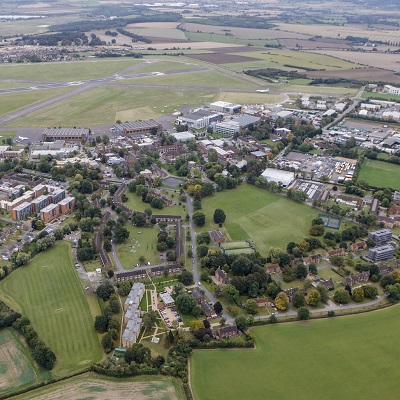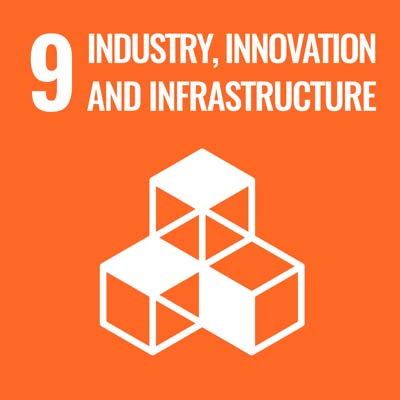Overview
- Start dateOctober
- DurationFull-time one year; part-time up to three years; PgCert 1 year; PgDip 2 years.
- DeliveryTaught modules 40%, group project 20% (or dissertation for part-time students), individual project 40%.
- QualificationMSc, PgDip, PgCert
- Study typeFull-time / Part-time
- CampusCranfield campus
Who is it for?
This course is applicable to a broad range of applicants with backgrounds from aerospace, engineering, maths, physics and computing to experienced professionals looking to gain new skills in the area of digital aviation technology.
The course is also a route for non-aerospace engineering and computing graduates who aspire to enter the aviation industry. In addition, the course is a career development path for aerospace industry professionals to boost their digital and innovation skills.
Why this course?
New and emerging generations of connected aircraft are entering service at pace. Aviation digitalisation spans the aircraft, airline, airport, airspace, MRO, ground operations, lessors and the wider ecosystem. New skills in the Internet of Things, robotics, AI, machine learning, AR/VR, big data analytics, predictive maintenance, blockchain, etc. are sought by the industry. While the digital technology is similar to other industrial sectors, the safety conscious and highly-regulated aviation industry imposes technology adoption hurdles specific to the aerospace regulatory and culture.
During the course you will have access to:
- The unique Cranfield global research airport learning environment.
- World-leading research centres. Cranfield University IVHM Centre has been leading research in the predictive health maintenance with technology adopted by major aircraft manufacturers.
- Digital MRO and hangar laboratories together with the Cranfield Boeing 737-400 ground demonstrator.
- HILDA digital high performance computing ecosystem with up to 10.5 PetaFlops processing power, 2.5 PB storage and 200GBits/s network.
- Industrial standard aviation IT systems.
You will gain hands-on experience via practical research projects that make up 60% of the study. The group design project (GDP) aims to develop your professional practice to work as part of a team, plan and manage projects, and communicate ideas and results. During GDP project you will design, implement, validate and test an aspect of digital aviation, applying the knowledge acquired in the taught modules and integrate the various methods learnt.
The individual research projects (IRPs) allow the students to specialise in a digital aviation topic relevant to their career development. The real-world relevance of the research project topics is an effective differentiator in the job market.
Informed by industry
The MSc in Aviation Digital Technology Management has been developed following consultation with our Industrial Advisory Board (IAB), comprising leaders from Boeing, Etihad, easyJet, Saab, STS Aviation, SITA, Thales, TUI, and others across the aviation sector. As such, the course content meets the requirements of the industry, now and in the future.Course details
The MSc course consists of three weighted components, taught modules and individual research project, and a group project.
Between October and January, students study eight taught modules. The content delivery is organised as one week contact time followed by private study time to complete the assessments. Pre-work and post-work are incorporated as appropriate. Private study weeks are spaced through the October to January period.
The learning journey support students in two complementary digital careers directions: a technical direction to add cyber-physical capability to automate aircraft and facilities operations; and an informatics direction to focus on the management and exploitation of the large volume of aviation data. The taught modules build the components for progression to the projects. The Aviation Digitalisation module establishes the foundation of the aviation industrial ecosystem. The Digital Engineering and the Data-Centric Aircraft Systems modules together build the technical basis of intelligent aviation. The Predictive Maintenance Technology and the Aerospace Inspection and Monitoring Tools modules cover the technology for digitalisation of the aviation asset operations and maintenance. The Digital Aviation Operations and Maintenance Management and the Digital Aviation Supply Chain Management modules bring together the internal and external views of aviation management. The Communications and Cybersecurity in Aviation module covers the secure communication needed in all aspects of technology and operations. The pre-requisite module path is illustrated in the diagram.
Students are supported in their learning and personal development through participation in: industry seminars, group poster session, group discussions, group presentations, video demonstrations, case studies, laboratory experiments, coursework and project work. Students will receive hands-on experience accessing equipment and facilities within our Digital Aviation Research and Technology Centre and Aerospace Integration Research Centre.
Course delivery
Taught modules 40%, group project 20% (or dissertation for part-time students), individual project 40%.
Group project
The group design project is a full time challenge to tackle a real industrial problem within a fixed 12 week timescale. The group of students are expected to professionally deliver working results to the sponsor at the end of the project. This learn-by-doing approach integrates the knowledge students gained in the taught modules. The collaborative experience prepares students to work in teams with members having diverse backgrounds and expertise, project management and technical presentations.
Example projects include:
- Robotic inspection to support aircraft maintenance.
- Fusion of location and camera sensing to support maintenance personnel electronic sign-offs.
- Autonomous collision avoidance in aircraft maintenance hangar.
- Multi-person AR/wearable supported aircraft maintenance.
Individual project
The Individual Research Project prepares students for their chosen career. This is a structured programme for the student to demonstrate his/her ability to conduct original investigations, to test ideas and to obtain appropriate conclusions from the work. Our industry partners sponsor and support practical projects that meet their business needs. Research focus projects could be agreed for students seeking academic career.
For part-time students it is common that their research thesis is undertaken in collaboration with their place of work.
Example projects include:
- Monitoring robotic vehicle movements using precision location system.
- Aircraft damage detection using hangar surveillance cameras.
- Lean operations in the hangar of the future.
- Parked aircraft maintenance programme.
- UAV operations and maintenance management system.
Modules
Keeping our courses up-to-date and current requires constant innovation and change. The modules we offer reflect the needs of business and industry and the research interests of our staff and, as a result, may change or be withdrawn due to research developments, legislation changes or for a variety of other reasons. Changes may also be designed to improve the student learning experience or to respond to feedback from students, external examiners, accreditation bodies and industrial advisory panels.
To give you a taster, we have listed the compulsory and elective (where applicable) modules which are currently affiliated with this course. All modules are indicative only, and may be subject to change for your year of entry.
Course modules
Compulsory modules
All the modules in the following list need to be taken as part of this course.
Aviation Digitalisation
| Aim |
|
|---|---|
| Syllabus |
|
| Intended learning outcomes |
On successful completion of this module, you will be able to:
|
Aviation Applied Computing
| Aim |
|
|---|---|
| Syllabus |
|
| Intended learning outcomes |
On successful completion of this module you should be able to:
|
Data-centric Aircraft Systems
| Aim |
|
|---|---|
| Syllabus |
|
| Intended learning outcomes |
On successful completion of this module, you will be able to:
|
Predictive Maintenance Technology
| Aim |
|
|---|---|
| Syllabus |
|
| Intended learning outcomes |
On successful completion of this module, you will be able to:
|
Aerospace Inspection and Monitoring Tools
| Aim |
|
|---|---|
| Syllabus |
|
| Intended learning outcomes |
On successful completion of this module, you will be able to:
|
Digital Aviation Operations and Maintenance Management
| Aim |
|
|---|---|
| Syllabus |
|
| Intended learning outcomes |
On successful completion of this module, you will be able to:
|
Digital Aviation Supply Chain Management
| Aim |
|
|---|---|
| Syllabus |
|
| Intended learning outcomes |
On successful completion of this module, you will be able to:
|
Communications and Cybersecurity in Aviation
| Aim |
|
|---|---|
| Syllabus |
|
| Intended learning outcomes |
On successful completion of this module, you will be able to:
|
Teaching team
You will be taught by Cranfield's experienced academic staff. Our staff are practitioners as well as tutors. Knowledge gained working with our clients is continually fed back into the teaching programme, to ensure provision of durable and transferrable skills practised on problems relevant to industry. Additionally, experienced members of the Industrial Advisory Board deliver industrial seminars in which they share their experience and explain the research and development proprieties of their companies. The Course Director for this programme is Dr Ip-Shing Fan.
Accreditation
Accredited by BCS, The Chartered Institute for IT for the purposes of partially meeting the academic requirement for registration as a Chartered IT Professional and Accredited by BCS, The Chartered Institute for IT on behalf of the Engineering Council for the purposes of partially meeting the academic requirement for a Chartered Engineer.
This course is accredited with the BCS until August 2028. Candidates must hold a CEng-accredited BEng/BSc (Hons) undergraduate first degree to comply with full CEng registration requirements.
Cranfield’s new MSc in Aviation Digital Technology Management will provide industry with the skills needed to develop integrated digital systems capability to support aircraft operations.
Not only is this key for MROs and airlines but also for the growing number of technology companies that provide ERP solutions for aircraft operations. Lots of good solutions exist within airlines and MROs that address elements of operations (traffic, movements, status, procurement, maintenance management, quality, safety etc) but the future opportunity is integrated solutions at the industry level. This MSc will help develop people who understand the ecosystem of aviation operations and the systems requirements needed to create innovative solutions for the future.
I think DARTeC is hugely exciting for Cranfield. Aerospace is absolutely at the heart of what we do as an institution and DARTeC brings together the many different disciplines across the university. This is a really strong example of where all the university's strengths converge to solve one of society's challenges.
Your career
Industry-led education makes Cranfield graduates some of the most desirable all over the world for recruitment by both global primes to smaller innovative start-ups looking for the brightest talent.
Graduates of the course should find engineering and management opportunities in the aviation ecosystem, including operators, maintenance organisations, financiers, airports and future spaceport operators.
Graduates will be equipped with the advanced skills which could be applied to the aviation, air traffic, air transport, security, defence, and aerospace industries. This approach offers you a wide range of career choices in current and emerging roles. Others decide to continue their education through PhD studies available within Cranfield University or elsewhere.
Cranfield’s Career Service is dedicated to helping you meet your career aspirations. You will have access to career coaching and advice, CV development, interview practice, access to hundreds of available jobs via our Symplicity platform and opportunities to meet recruiting employers at our careers fairs. Our strong reputation and links with potential employers provide you with outstanding opportunities to secure interesting jobs and develop successful careers. Support continues after graduation and as a Cranfield alumnus, you have free life-long access to a range of career resources to help you continue your education and enhance your career.
Read our blog post: Is a career in digital aviation right for you?
How to apply
Click on the ‘Apply now’ button below to start your online application.
See our Application guide for information on our application process and entry requirements.
















